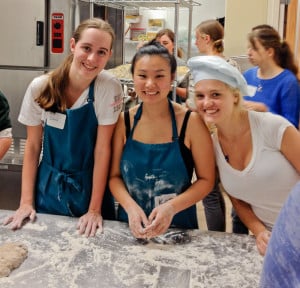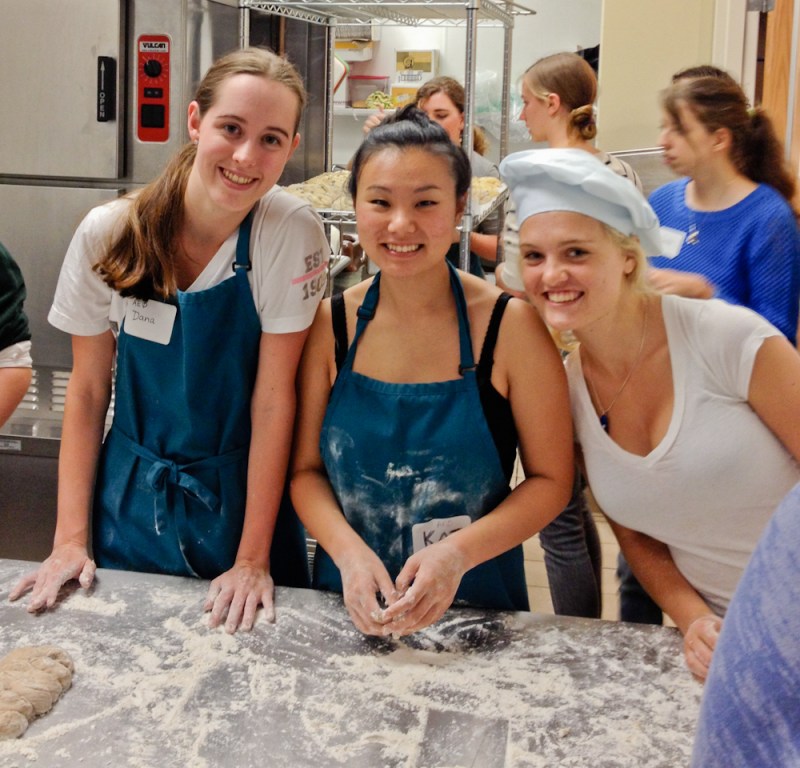
With a taste for quality challah and an appetite for social impact, Stanford’s Challah for Hunger group meets every Thursday to bake for charitable work.
The student group, sponsored by the Jewish Student Association, is a chapter of the national Challah for Hunger campaign to bake and sell challah for charity. Stanford’s chapter, which began in 2009, has quickly gained a notable reputation as one of the biggest chapters in the country.
While many other chapters bake about 30 loaves per week, Stanford’s output has reached around 200 or more per week this quarter, according to Rachel Waltman ’15, Challah for Hunger volunteer manager.
Lauren Sweet ’15, a co-director of the group who has been involved since her freshman year, notes that the group’s presence on campus has grown in the last three years, something that fellow co-director Sarah Beller ’15 said has contributed to a greater sense of community.
“There’s a wonderful campus community here,” Beller said. “It comes together to make a really strong, vibrant program.”
The growing demand for challah mirrors a growing desire to bake. The Hillel kitchen fills up with volunteers from across the University-from returning volunteers and their friends to students simply drawn in by the sweet-smelling aroma that surrounds the Koret Pavilion at Hillel each week.
Each week an organization co-sponsors Challah for Hunger and brings in its own set of new faces as well.
While 50 percent of Challah for Hunger profits go to the American Jewish World Service-an organization that provides humanitarian aid to countries in need such as Darfur-the remaining 50 percent of funds are donated to an organization of the co-sponsor’s choice.
In the past quarter, AEPhi donated its funds to Sharsheret to support women with breast cancer; the Bridge Peer Counseling Center contributed its share towards brain and behavior research; and Camp Kesem gave its funds to the national Camp Kesem organization that helps kids who have been affected by a parent’s cancer, Waltman said.
Waltman added that making the bread is “a pretty time-intensive process, but it’s always worth it.”
The two-hour dough-making shift begins at 4 p.m., marking what Waltman describes as a cathartic time to release stress by manually mixing the ingredients (approximately 162 pounds of dough for the 200 loaves each week) while chatting with friends.
After another two hours during which the dough rises, a new batch of volunteers begins the braiding and baking shift. Finally, around 9:30 p.m., the selling begins.
The whole process is both social and philanthropic.
“I really enjoy watching volunteers having a good time,” Sweet said. “When you have music and you get a really enthusiastic group of volunteers who are dancing and singing and throwing flour around, it makes a mess but it makes the experience really enjoyable.”
In order to make the experience as pleasant as possible for volunteers, the Challah for Hunger board continually reflects on the process. After each baking session, they meet to discuss what went well and what didn’t, so that they may continue to improve the experience for everyone.
Weekly flavors include chocolate chip, garlic rosemary, cinnamon raisin and classic plain. Rather than using the national Challah for Hunger recipe, the student group sticks to “Malkie’s Challah Recipe,” offered by Malkie Kamin, the wife of Stanford Rabbi Ephraim Kamin.
Moreover, a special flavor of the bread is added each week. These flavors are the result of an experimental bake that the Challah for Hunger board carries out each quarter.
The board meets to brainstorm a list of potential flavors, buys the ingredients for the most popular ideas, creates a batch of the base dough and then adds the flavors in experimental proportions. Afterward, the group sits around and tastes the different flavors, sharing opinions at will about both the flavor’s taste and its ability to scale.
“It’s all very pretentious-sounding, like wine tasting but with challah,” Sweet said about the discussions.
Although some ideas fail, such as a Valentine’s Day-themed strawberry jam with chocolate experiment that was too sticky to scale well, others have become very popular, Beller said. For example, the pumpkin challah, when available, outsells every other flavor.
Additionally, the board always remains open to flavor suggestions from the greater community.
With passionate leaders, a strong community of volunteers and a goal of giving to a variety of social causes, Challah for Hunger has the ingredients to continue to grow as an influential group.
“For me, it’s absolutely chaotic during the baking period,” Waltman said, “but when you see people finally walk away with their loaf of challah and they’re just so happy, you can tell it’s the highlight of their week. It’s all worth it.”
Contact Jenna Shapiro at jennshapa ‘at’ stanford.edu.
